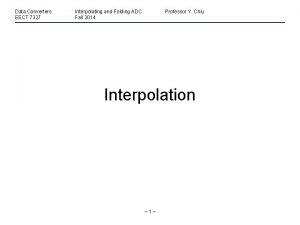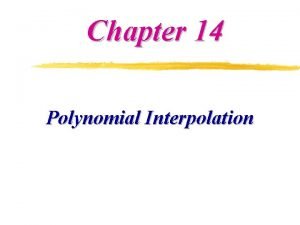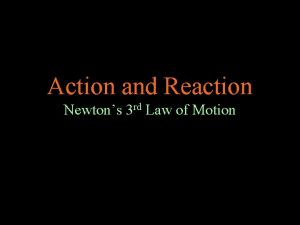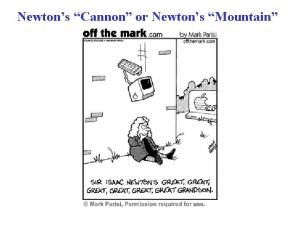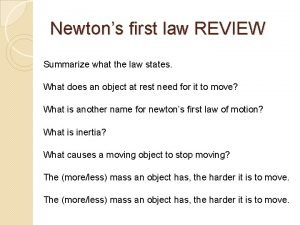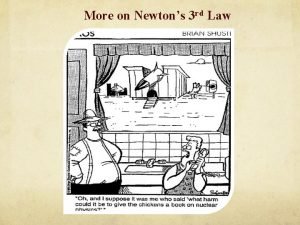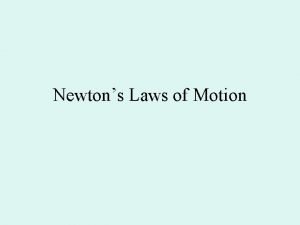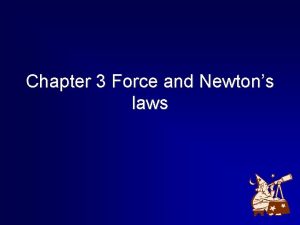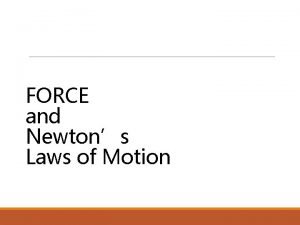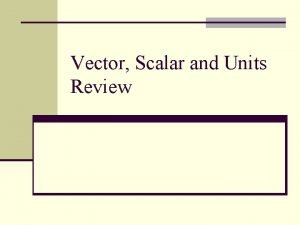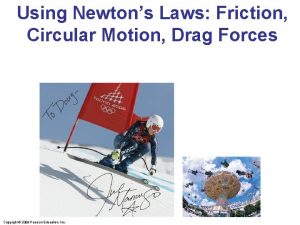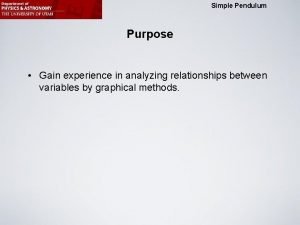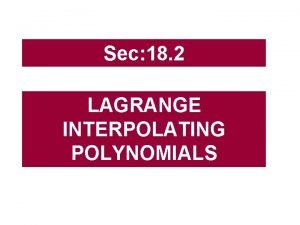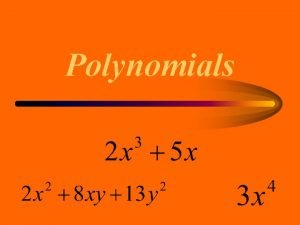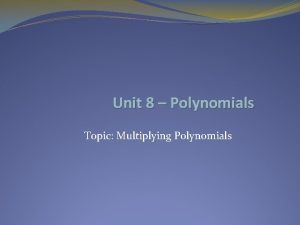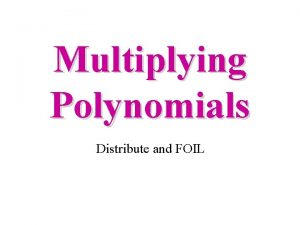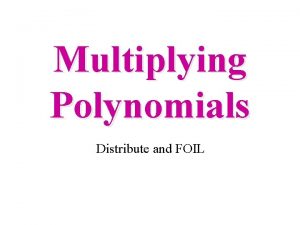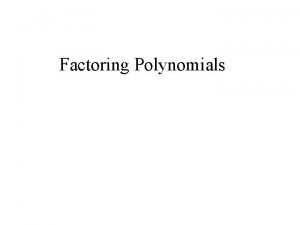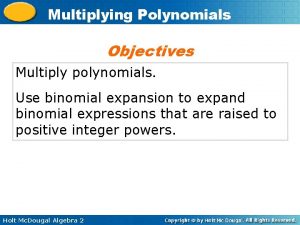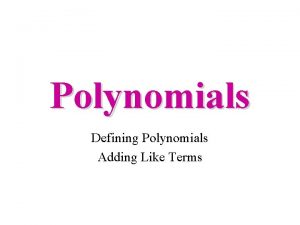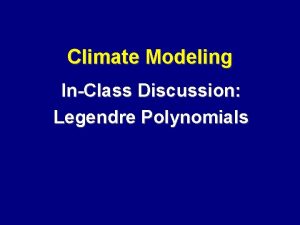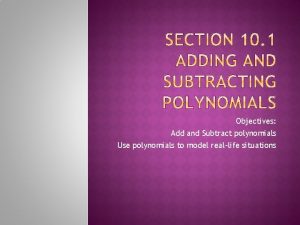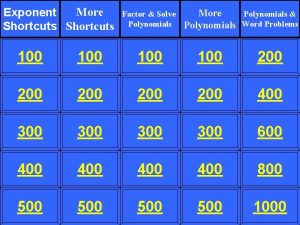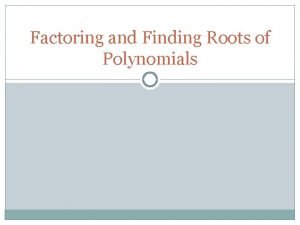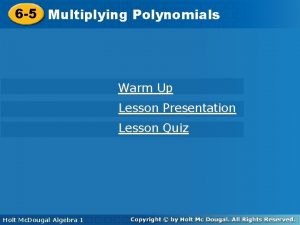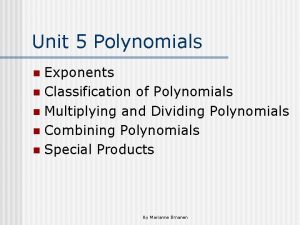Sec 18 1 NEWTONS DIVIDEDDIFFERENCE INTERPOLATING POLYNOMIALS Sec























- Slides: 23

Sec: 18. 1 NEWTON’S DIVIDEDDIFFERENCE INTERPOLATING POLYNOMIALS

Sec: 18. 1 NEWTON’S DIVIDED-DIFFERENCE INTERPOLATING POLYNOMIALS How many lines passes through these two points ? How many parabola passes through these three points ? How many polynomial of degree one passes through these two points ? there is one and only one polynomial of order n that passes through all the points. …… How many polynomial of degree n passes through these (n+1) points ? How many polynomial of degree two passes through these three points ? Polynomial interpolation consists of determining the unique nth-order polynomial that fits n + 1 data points.

Sec: 18. 1 NEWTON’S DIVIDED-DIFFERENCE INTERPOLATING POLYNOMIALS …… Polynomial interpolation consists of determining the unique nth-order polynomial that fits n + 1 data points. How many polynomial of degree n passes through these (n+1) points ? Applications X Y X f(x) Sometimes we need to estimate intermediate values between precise data points. 2. 1 99. 0 x 1 f(x 1) 3. 7 23. 56 x 2 f(x 2) Sometimes we need to a function by nth-order polynomial … … 35. 6 22. 12 xn f(xn)

Sec: 18. 1 NEWTON’S DIVIDED-DIFFERENCE INTERPOLATING POLYNOMIALS Linear Interpolation Example Estimate the natural logarithm of 2 using linear interpolation. First, perform the computation by interpolating between ln 1 = 0 and ln 6 = 1. 791759. = 0. 3583519

Sec: 18. 1 NEWTON’S DIVIDED-DIFFERENCE INTERPOLATING POLYNOMIALS Quadratic Interpolation A particularly convenient form

Sec: 18. 1 NEWTON’S DIVIDED-DIFFERENCE INTERPOLATING POLYNOMIALS A particularly convenient form finite divided differences Definition:

Definition: Sec: 18. 1 NEWTON’S DIVIDED-DIFFERENCE INTERPOLATING POLYNOMIALS second finite divided difference nth finite divided difference

Sec: 18. 1 NEWTON’S DIVIDED-DIFFERENCE INTERPOLATING POLYNOMIALS Example Fit a second-order polynomial to the three points

Definition: Sec: 18. 1 NEWTON’S DIVIDED-DIFFERENCE INTERPOLATING POLYNOMIALS second finite divided difference nth finite divided difference General Form of Newton’s Interpolating Polynomials

Sec: 18. 1 NEWTON’S DIVIDED-DIFFERENCE INTERPOLATING POLYNOMIALS notice how divided differences are recursive that is, higher-order differences are computed by taking differences of lower-order differences.

Sec: 18. 1 NEWTON’S DIVIDED-DIFFERENCE INTERPOLATING POLYNOMIALS Example Calculate f (4) using Newton’s interpolating polynomials of order 1 through 3. Given the data First 1 3 2 6 3 19 5 99 Second Third

Sec: 18. 1 NEWTON’S DIVIDED-DIFFERENCE INTERPOLATING POLYNOMIALS Example Calculate f (4) using Newton’s interpolating polynomials of order 1 through 3. Given the data First Second Third 1 1 3 3 5 2 6 13 9 3 19 40 5 99

Sec: 18. 1 NEWTON’S DIVIDED-DIFFERENCE INTERPOLATING POLYNOMIALS Example Complete the divided difference table for the data given in the adjacent Table and construct the interpolating polynomial that uses all this data. Second Third − 0. 4837057 − 0. 1087339 0. 0658784 0. 6200860 − 0. 5489460 − 0. 0494433 0. 0680685 1. 6 0. 4554022 − 0. 5786120 0. 0118183 3 1. 9 0. 2818186 − 0. 5715210 4 2. 2 0. 1103623 0 1. 0 0. 7651977 1 1. 3 2 First x 1. 0 1. 3 1. 6 1. 9 2. 2 f (x) 0. 7651977 0. 6200860 0. 4554022 0. 2818186 0. 1103623 Fourth 0. 0018251 The coefficients of the Newton forward divided-difference form of the interpolating polynomial are along the first row in the table.

Sec: 18. 1 NEWTON’S DIVIDED-DIFFERENCE INTERPOLATING POLYNOMIALS Second Third − 0. 4837057 − 0. 1087339 0. 0658784 0. 6200860 − 0. 5489460 − 0. 0494433 0. 0680685 1. 6 0. 4554022 − 0. 5786120 0. 0118183 3 1. 9 0. 2818186 − 0. 5715210 4 2. 2 0. 1103623 0 1. 0 0. 7651977 1 1. 3 2 First Fourth 0. 0018251 Remark The coefficients of the Newton forward divideddifference form of the interpolating polynomial are along the first row in the table. Remark The poly of degree 1 for (1. 0. 7651977) and (1. 3, 0. 6200860) Remark If poly of degree 5 is needed, then just complete the diagonal.

Sec: 18. 1 NEWTON’S DIVIDED-DIFFERENCE INTERPOLATING POLYNOMIALS data=[1. 0 0. 7651977; 1. 3 0. 6200860; 1. 6 0. 4554022; 1. 9 0. 2818186; 2. 2 0. 1103623]; x =data(: , 1); y=data(: , 2); [d]=Divided_diff(x, y); d function [d]=Divided_diff(x, y) d=y; n=length(x); for j=2: n for k=n: -1: j d(k)=(d(k)-d(k-1))/(x(k)-x(k-j+1)); end Second Third − 0. 4837057 − 0. 1087339 0. 0658784 0. 6200860 − 0. 5489460 − 0. 0494433 0. 0680685 1. 6 0. 4554022 − 0. 5786120 0. 0118183 3 1. 9 0. 2818186 − 0. 5715210 4 2. 2 0. 1103623 0 1. 0 0. 7651977 1 1. 3 2 First Fourth 0. 0018251

Sec: 18. 1 NEWTON’S DIVIDED-DIFFERENCE INTERPOLATING POLYNOMIALS Example Given the data Write the Newton’s interpolating polynomials of order 4. First 1 3 2 6 3 19 5 99 7 291 Second Third Fourth

Sec: 18. 1 NEWTON’S DIVIDED-DIFFERENCE INTERPOLATING POLYNOMIALS Example Write the Newton’s interpolating polynomials of order 4. Given the data First Second Third Fourth 0 1 3 3 5 1 2 6 13 9 1 3 19 40 14 5 99 96 7 291

Sec: 18. 1 NEWTON’S DIVIDED-DIFFERENCE INTERPOLATING POLYNOMIALS Example Problem 18. 2 pp 522 Fit a third-order Newton’s interpolating polynomial to estimate log(10) using the data at x = 8, 9, 11 and 12. Compute the true percent relative error. 8 9 11 12 x=[8 9 11 12]; y=log 10(x); [d]=Divided_diff(x, y); d [yi] = eval_poly(x, d, 10) Rel_err = (yi-1)/1*100 function [yi] = eval_poly(x, d, xi) yi = d(1); prod = 1; n = length(d); for k=1: n-1 prod=prod*(xi-x(k)) yi=yi+d(k+1)*prod; end 0. 9031 0. 9542 1. 0414 1. 0792 True percent relative error = 0. 0045% 0. 9031 0. 0512 -0. 0025 0. 0001

Sec: 18. 1 NEWTON’S DIVIDED-DIFFERENCE INTERPOLATING POLYNOMIALS Example Problem 18. 2 pp 522 x=[0 pi/2 pi 3*pi/2 2*pi]; y=sin(x); [d]=Divided_diff(x, y); xx=[0: 0. 1: 2*pi]; [yy] = eval_poly(x, d, xx); ezplot('sin(x)', [0, 2*pi]); grid on; hold on plot(xx, yy); plot(x, y, 'k*'); hold off

Sec: 18. 1 NEWTON’S DIVIDED-DIFFERENCE INTERPOLATING POLYNOMIALS Errors of Newton’s Interpolating Polynomials The structure is similar to the Taylor series expansion in the sense that terms are added sequentially to capture the higher-order behavior. Taylor series

Sec: 18. 1 NEWTON’S DIVIDED-DIFFERENCE INTERPOLATING POLYNOMIALS Errors of Newton’s Interpolating Polynomials For an nth-order interpolating polynomial, an alternative relationship for the error is

Sec: 18. 1 NEWTON’S DIVIDED-DIFFERENCE INTERPOLATING POLYNOMIALS nth-order error is Example Problem 18. 2 pp 522 Fit a second-order Newton’s interpolating polynomial to estimate log(10) using the data at x = 8, 9, and 11. Compute the true error. 8 0. 9031 9 0. 9542 11 1. 0414 12 1. 0792 x=[8 9 11]; y=log 10(x); 0. 9031 [d]=Divided_diff(x, y); 0. 0512 [yi] = eval_poly(x, d, 10) -0. 0025 err = yi-1 (*)

Sec: 18. 1 NEWTON’S DIVIDED-DIFFERENCE INTERPOLATING POLYNOMIALS Notation
 Folding adc
Folding adc Divided difference formula
Divided difference formula Newtons 3 rd law of motion
Newtons 3 rd law of motion Site:slidetodoc.com
Site:slidetodoc.com Physics
Physics Newtons mountain
Newtons mountain What the law
What the law فرمول نیوتون
فرمول نیوتون What is motion
What is motion Newtons 3 rd law
Newtons 3 rd law Exempel på motkraft
Exempel på motkraft What does f=ma mean
What does f=ma mean Section 3 using newtons law
Section 3 using newtons law Example for newton's first law of motion
Example for newton's first law of motion Third law of thermodynamics derivation
Third law of thermodynamics derivation The 3 law of motion
The 3 law of motion Newtons 3 rd law
Newtons 3 rd law Newtons laws definitions
Newtons laws definitions Newtons bio
Newtons bio Joules scalar or vector
Joules scalar or vector Rd law
Rd law Newtons laws
Newtons laws Newtons second aw
Newtons second aw Types of pendulum in physics
Types of pendulum in physics
